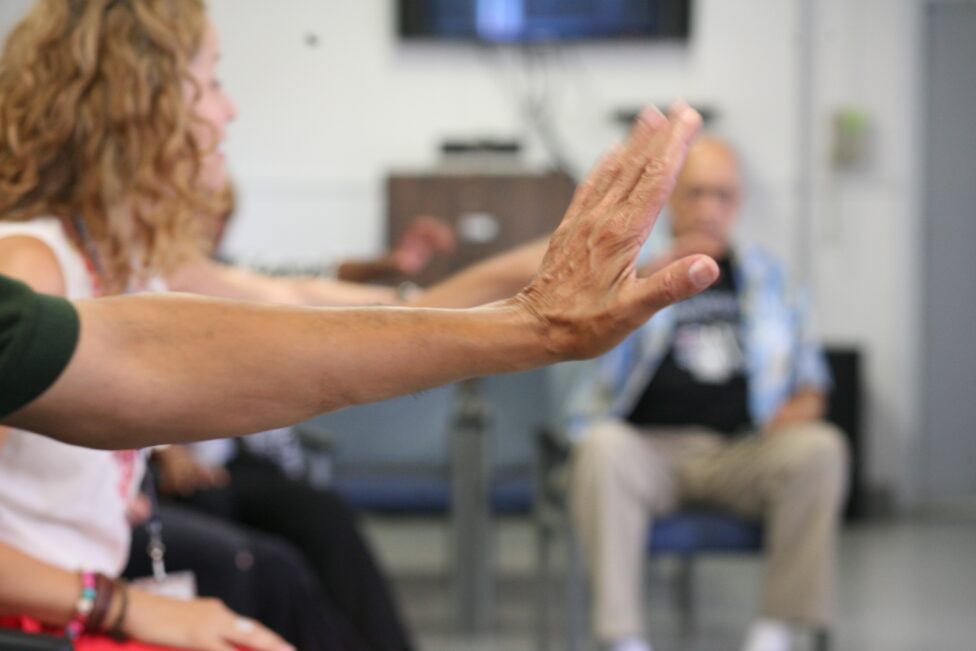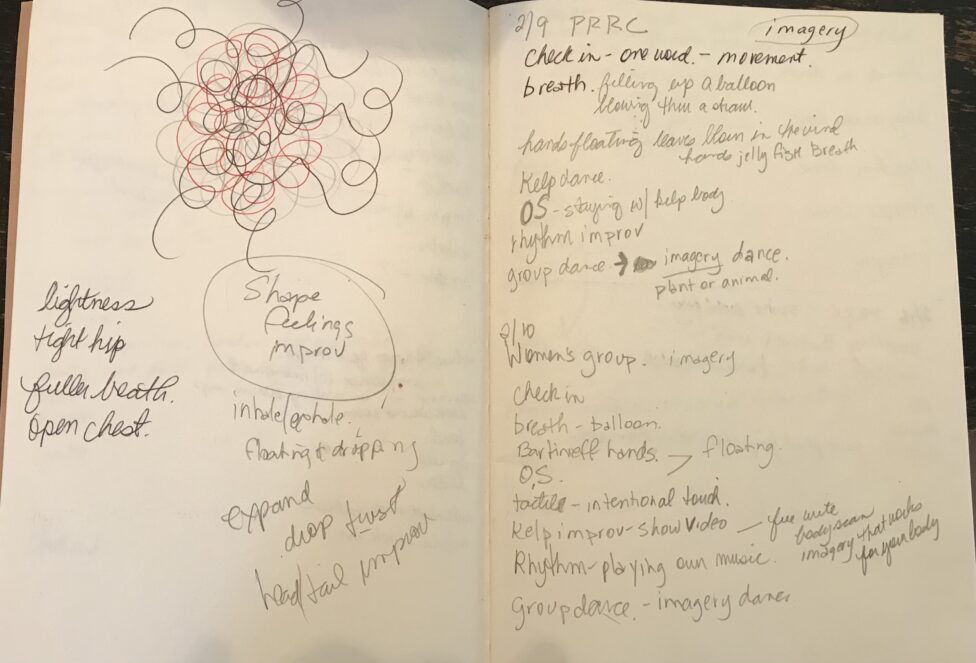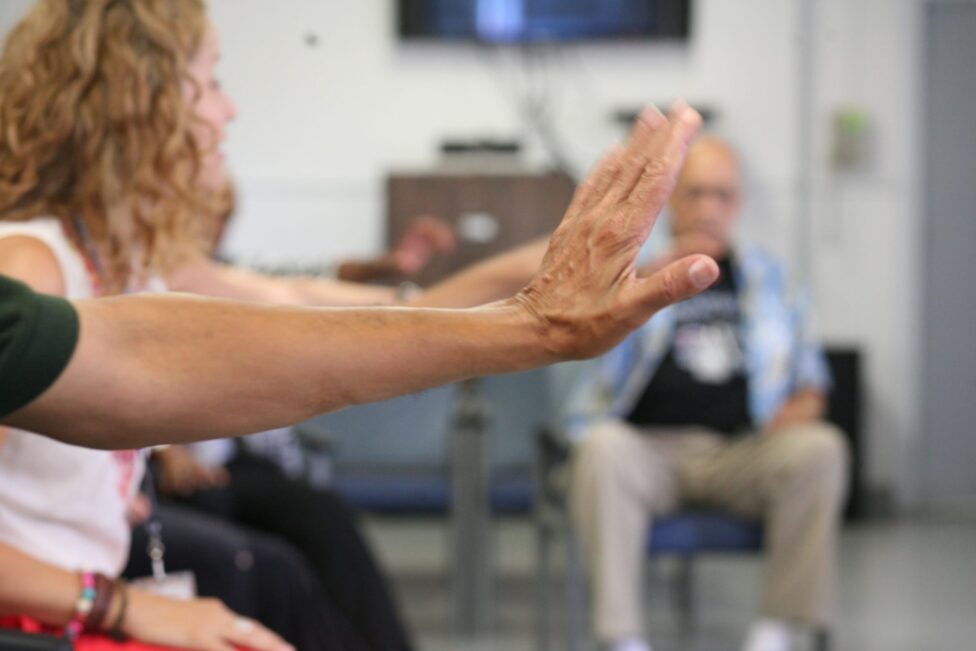Day -4 pre-COVID time
I can’t sleep. Why did I say yes to this? Tomorrow I’m supposed to go back to the lockdown psychiatric ward. I’m training the recreation therapist in the ward. I’m nervous. I’ve trained dozens of clinicians and worked with veterans with lots of conditions ranging from PTSD to chronic pain to memory loss. I have taught classes in conference rooms, cafeterias, and therapy pools. I had never been in a psychiatric ward until last month. Is dance really gonna work? Don’t these folx have bigger problems to deal with? Why would they want to dance?
Day 362 COVID time
I’ve been wanting to write about my work with veterans for quite some time now. Look I certainly don’t want to silver-line this horrible pandemic. And yet, the plus side of all the canceled gigs, classes, and residencies has allowed me the time and space to reflect and write about it—beyond the many grants I’ve written. I will spare you that writing.
The days blur into one another. I wake up every morning and my first thought is usually something like: “What am I going to have for dinner tonight?” As if eating is my only joy left in life. It isn’t—dancing and teaching veterans from my bedroom has truly been my lifeline.
I’m gonna go way back in time a moment…

Photo courtesy of the artist
Day -3,867 pre-COVID time (i.e. 11 years ago)
I’m invited to partner with dance educators Kristen Smiarowski, Sarah Wilbur and mental health professionals to co-create “Dance for Veterans.” On the one hand I’m excited; and on the other, I’m like, ME? I have no mental health expertise, a brief time working with veterans and zero experience working in a medical/clinical setting. But I can create a helluva lesson plan with a great playlist. And I love teaching and creating with communities that don’t necessarily identify as dancers. So ok I’m game.
Side note: (And yes, I’ve learned a ton in the past 11 years but that’s another article)
Cut to…
Day 120 Covid time
I’ve been teaching three online classes/week for veterans since last month: one for women, another for a “senior” group and then another for veterans with severe mental health challenges. I set up my pandemic dance studio: I make my bed, plug in my external microphone and speaker, stack books on the desk to raise my computer, and open up the shutters for natural light. Then I ask my son not to simultaneously watch YouTube videos, play video games, or chat on Discord while on his school Zoom lesson. Spare some bandwidth, dude! The last step is a fleeting return to doubt: Why dance?
Despite these thoughts, I log into my computer and, inevitably, people show up, veterans age 25 to 92 from all backgrounds. They are also in their bedrooms or kitchens or living rooms. They are also tired, angry, and lonely. Yet they are always ready to move, share, and create. We breathe and meditate together. Using elements from yoga, qi gong and Bartenieff Fundamentals, we warm up. We challenge our coordination. And most importantly we collectively create together. We make dances around what gifts we bring to the table or what delights us (inspired by Ross Gay’s Book of Delights). Today at the beginning of class, a veteran talked about how on her daily walks she had been seeing a lot of couches out for trash pickup. Her thought was that people were buying new couches since they were home all the time and wanted to be more comfortable. She then provided the group with a wonderful prompt: “I think we should make a dance about that today. What gives us comfort?”
Day 150 COVID time
This morning I led the women’s group. Our theme was grounding. How do we ground ourselves through these uncertain, turbulent times? I offer ways to dance and move and breathe our way into feeling grounded. We also share with each other our own grounding practices: being in nature, walking in our garden, watching the birds, going for a drive. Across the board, they also said these classes ground them. One veteran told another veteran that she cares for her as a “sister.” They have never met in person. Another told another that her peaceful face calms her. Another observed the movement growth in another: “You look so much freer as you dance now.” It was a beautiful thing to witness.
Day 215 COVID time
Today we sang happy birthday to a veteran and we each offered a birthday dance in her honor. Through tears she told us how much this time together meant to her on her birthday that otherwise would have been spent alone.
Day 282 COVID time
Our last class before the holidays. We made a dance about what we are moving towards in the new year. One vet jumped across his frame shouting, FREEDOM OF EXPRESSION, with his arms out wide. Another stood up and walked slowly to his monitor and bowed saying, “I’m moving towards healing.” It was a hopeful moment.
I generally dislike being on my computer. The online teaching I’ve done in the past has been sterile and tedious. Though I ache to share physical space, we continue to have beautiful connections in virtual space. In some ways it is more intimate. On camera, we’ve seen each others’ pets, children and grandchildren. We have made dances inspired by the precious objects spotted in our rooms. We’re peeking through windows into each other’s lives in ways that could never happen in a multi-purpose room.

Photo Courtesy of the Artist
Day 299 COVID time (a.k.a. January 6, 2021)
I woke up tired and grumpy and then became furious. I didn’t feel like dancing.
And yet, dancing has never failed me. It was my lifeline growing up in an unsafe alcoholic home where I did not feel heard. I spent most of the 90s choreographing dances where I was literally trying to speak but could not. Dancing kept me afloat during my own alcoholism and eventual sobriety. This era included a solo where I drank four beers while I told the audience I did not have a problem drinking. Dancing even pulled me through the dark tunnel of chronic back pain and deep depression—the positivity and generosity of dance teachers and colleagues led me to the light. Now, in this historic pandemic and the sea of awfulness that surrounds it, I look to dance to save me again. And even with all this evidence, all the faith I have built and invested in dance as a lifeline, I still doubt. Will it save me this time?
During our class’s opening check-in, I said I’m angry. And I shook my fists in front of me. The group, using our call and response form, shook their fists back at me. The flow of the class continued. Al Green’s “Love and Happiness” was playing as we did a body brushing practice—sweeping and brushing the surfaces of our body with our hands. The gripping anger was swept away. I had to tell myself, “Don’t cry, Christine. Keep it together, girl.” After the song was over I shared the experience with a relieved smile. In response one of the vets confidently said, “See, I knew dancing would help.”
And here we are…
Day 362 COVID time
He had no doubt about it, so why should I? These intrepid veterans have taught me to hold dancing even closer than before. These men and women who have experienced trauma beyond my comprehension but still have enough belief in the transformative power of movement to log into Zoom every week and dance with me in my bedroom. If my faith in dance ever falters, they are there to pick me up and remind me that it is my lifeline, my way back home.
A side note of gratitude: I want to thank Ann Haskins, Mark Rizzo, Jeff Slayton, and Anh Vo for their editorial support through this writing process. It has been both challenging and nurturing.
Cover Image Description:
A bare arm is outstretched with a flexed hand pointing to the right. Out of focus in the background is another person, seated in the same gesture.
Article Image Description:
An unlined notebook is spread to show red and black squiggles above notes and beginnings of a movement score. “Floating, dripping, expand, drop…”





